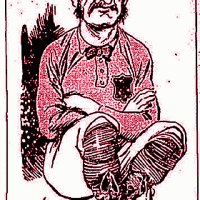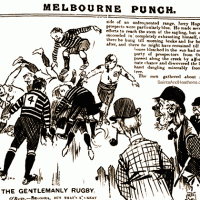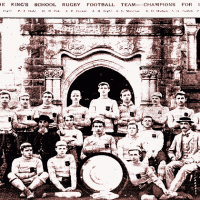The rise and fall of rugby in 1890s Melbourne coincides with the arrival and departure of Rev. John Hoatson.
Raised and educated in England, Hoatson was a significant figure in the development of Rugby in New Zealand’s Canterbury province in the 1880s, where he was a representative team selector and senior RU official. In the 1890s he would, with some success, work tirelessly towards establishing Rugby in Melbourne.

(image courtesy of of Westminster College, Cambridge / Congregational Year Book of 1911).
Hoatson arrived in New Zealand c.1883 and was in mid 1884 appointed pastor to the Trinity Congregational Church in Christchurch. He was apparently at this time a footballer with with a local Rugby team.
Wellington’s Evening Post (2 June 1917) said of him: “One of the best exponents of Rugby football in New Zealand many years ago was Rev. John Hoatson”, while New Zealand Free Lance (2 May 1903) noted: “The Rev. John Hoatson, who used to play a bit of Rugby football in this country…”
The Otago Witness (20 August 1886 & 1 July 1887) made mention of Hoatson’s ability to deliver “a speech full of capital advice to footballers” and that he “is a splendid judge of the game.”
Hoatson was also a highly regarded referee in Christchurch club football, as well as carrying the whistle in inter-provincial and representative matches, including Canterbury’s games against NSW (in 1886), British Lions and the New Zealand Natives team (both 1888).
Apparently well connected in Rugby circles, extracts of Rugby related letters between himself and Rowland Hill, Secretary of the RFU, were published in New Zealand newspapers in 1885. The Canterbury Times (clipped into the Otago Witness 3 December 1891) praised Hoatson and the influence he personally had made on the laws of the game:
“As far back as 1885 Mr Hoatson assisted in the selection of the teams to represent Canterbury and in 1887 was appointed sole selector. In a great many ways Mr Hoatson helped to advance the game, especially as a member of the Rugby Union and as a referee.
“No man in Christchurch had such a thorough knowledge of the rules as Mr Hoatson, and it was largely due to his energy that a number of desirable alterations to the rules were drawn up, and after being submitted to the other Unions in the colony, were forwarded to the English Rugby Union.
“Some of the alterations were adopted right away, and on various occasions since the parent body has seen the policy of adopting others which are now contained in the rugby rules only in a slightly different form from that submitted by the New Zealand unions.”
Hoatson arrived in Melbourne late in the winter of 1892, as the new pastor to the Congregational Church at Carlton.
He had come to Melbourne just as the football season was closing, but it wouldn’t have taken him long to conclude that Rugby was not played at all in Victoria.
As a man who possessed an obvious passion for the game, and as later comments would reveal, a fervent distaste for Australian rules, he could not remain idle.
Auckland’s Observer wrote on 27 May 1893:
“The Cup matches in connection with the newly-formed Rugby Union in Melbourne were to have commenced last Saturday. From the Melbourne Punch I learn that the credit of inaugurating the movement belongs to the Rev. Hoatson, who was ably assisted by Mr Arthur E. Lewis. These gentlemen have been elected vice-presidents of the Victorian Rugby Union in recognition of their services.”
At one of the first meetings of the newly formed NZRU (as reported in Wellington’s Evening Post, 5 June 1893):
“A mass of correspondence from affiliated unions, from English and Australian unions and various well-wishers of the New Zealand Union was read and dealt with.
“Amongst the letters was one received from the Rev. Mr. Hoatson, late of Canterbury, who has always been a supporter of the New Zealand Union, stating that they had succeeded in forming a Rugby Union at Melbourne, which was progressing favourably and had five clubs.
“There was also an allusion to the same subject in one of the New South Wales Union’s letters, which stated that the new union having secured a ground and made a good start, there was at last a good prospect of the rugby game taking a firm hold in Melbourne.”
In 1893, after the NSWRU seemed unable to placate Tom Ellison and his visiting New Zealand team over the officiating of NSW referees, the Union turned to Hoatson to break the impasse.
Reportedly “at great inconvenience to himself” Hoatson accepted the invitation and came to Sydney to control the NSW v New Zealand match at the SCG.
The Otago Witness (27 July 1893) wrote:
“The Sydney Referee has a good word to say for the ex-Christchuch resident, Mr Hoatson, who acted as referee in the return match at Sydney between the New Zealand Union team and New South Wales:— The Rev. Mr Hoatson, who hails from the old country, and who has for several years been a resident in New Zealand, where he obtained a great name for his umpiring, but who now resides in Melbourne, was the referee, and proved himself the right man in the right place. To him is due the fastness of the game, as he appears to take the rules in the spirit instead of the letter. His decisions were most impartial, and he gave general satisfaction.”
In a speech at the post match dinner (reported in The Sydney Morning Herald, 10 July 1893):
“Mr. Hoatson requested if they heard of any Rugby players going over to Melbourne to let the Victorian Rugby Union know, so that they might be able to get hold of those players in Melbourne before they had time to backslide into the slums of the Victorian game.”
Victorian representative teams chosen by Hoatson played against NSW in the winters of 1894-95, and he acted as referee for the matches in Melbourne. Reflecting earlier his words at the Sydney dinner, the majority of the players were not native Melburnians, but those having gained their Rugby education elsewhere.
Doubt remains about the extent of Rugby played during 1896-98. Queensland initially intended returning from their New Zealand tour in 1896 via Melbourne to play Victoria, but that failed to eventuate. The Observer (Auckland) reported on 30 May 1896 that Hoatson had again been elected by the VRU as a vice-president.
It took the news in early 1899 that a British Rugby team would be visiting Australia for the game to again rise in Melbourne, and Hoatson was quickly to the fore.
The Melbourne correspondent for The Referee wrote (5 July 1899) that “The few lovers of Rugby football in Melbourne have come out of their shells again, and, under the guidance of the Rev. J. Hoatson have formed a a club entitled the Victorian Wanderers RFC, in the hopes they may be able to arrange a match with the English team, and also with NSW and Queensland later on,” adding through the rest of July further reports advising that the match was confirmed, that it was now “a club of about 100 strong” and that “the club open their club rooms at 114 Elizabeth Street to-day.”
In the weeks before the arrival of the British team in Melbourne, trial matches were played each Saturday afternoon on the East Melbourne Cricket Ground, with Hoatson acting in the triple role of referee, on-field advisor and selector of the Victorian team. The Victorians also received a letter from the NSWRU opening talks for a proposed game between the two colonies.
Despite their energetic efforts to produce a competitive team, the Victorians were confronted by a British Lions party hardened by two months of matches throughout NSW and Queensland, and the home-side were crushed 30-0. Held on the Melbourne Cricket Ground, as part of a double-bill with an Australian rules match, it was estimated there were 10,000 present to watch the first half of the Rugby contest.
In what surely must be a rarity in international contests, the referee (Hoatson) and one of the captains were both reverends (the British were led by Rev. Matthew Mullineux).
Barely weeks later, Hoatson accepted a position as the pastorate of the Congregational Church at Leek, Staffordshire, allowing him the opportunity to return with his wife and two children to England – they left almost immediately.
Though Rugby would have played no part in his decision to leave or not, it is reasonable to conclude that Hoatson departed feeling confident that the city’s 100-member strong Rugby club was the birth of a permanent Rugby presence in Melbourne, and that the promised game against NSW could be readily arranged for 1900.
In May 1900 the “Victorian Rugby Club” played a practice match at the Middle Park Ground (Albert Park), but then no further games were held, and the movement collapsed.
That it could all dissolve away so quickly is a measure of how vital and persuasive Hoatson must have been in encouraging the playing, organising and supporting of the game.
A club Rugby competition was finally established in Melbourne in 1909. Though Hoatson obviously had no involvement in that organisation, it seems unlikely it could have come to fruition if not for the underlying legacy of his work and influence on Rugby in Melbourne in its pioneering decade before.
© Sean Fagan











